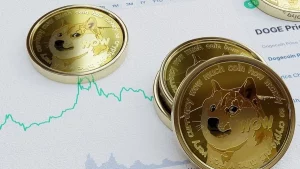Cryptocurrencies have taken the world by storm in recent years, with Bitcoin being the most well-known and widely used. However, there are numerous other digital currencies that have gained popularity and one such example is Dogecoin. Launched as a playful joke in 2013, Dogecoin has now become a serious contender in the cryptocurrency market. In this article, we will dive into the world of Dogecoin and explore the question that many people have been asking – how many Dogecoins are there?
Outline:

- Introduction to Dogecoin
- What is Dogecoin?
- History of Dogecoin
- Popularity of Dogecoin
- Creation and Supply of Dogecoin
- Mining Dogecoin
- Proof-of-work Algorithm
- Block Rewards
- Total Supply of Dogecoin
- Initial Supply
- Inflationary System
- Current Circulating Supply
- Mining Dogecoin
- Factors Affecting Supply and Price of Dogecoin
- Demand and Adoption
- Market Manipulation
- Network Difficulty
- Comparison with Other Cryptocurrencies
- Bitcoin vs. Dogecoin
- Litecoin vs. Dogecoin
- Future of Dogecoin
- Potential for Growth
- Integration into Mainstream Markets
- Conclusion
Introduction to Dogecoin

What is Dogecoin?
Dogecoin is a decentralized, peer-to-peer digital currency that operates on a blockchain network. It was created by Billy Markus and Jackson Palmer as a “joke currency” in 2013, inspired by the popular “Doge” meme featuring a Shiba Inu dog. Despite its humorous origins, Dogecoin quickly gained a following and has now become a serious contender in the world of cryptocurrencies.
History of Dogecoin
Dogecoin was officially launched on December 6, 2013 and quickly gained popularity due to its comedic origins and low transaction fees. Within the first month of its launch, it had already reached a market capitalization of over $8 million. In January 2014, the Dogecoin community raised $25,000 worth of Dogecoin to sponsor the Jamaican bobsled team to compete in the Winter Olympics. This move not only brought attention to Dogecoin, but also highlighted the community’s charitable nature.
In 2015, Dogecoin experienced a major hack which led to the theft of millions of coins from the Dogecoin wallet platform, DogeVault. However, this did not deter the popularity of Dogecoin and it continued to thrive with new partnerships and integrations into various platforms.
Popularity of Dogecoin
Today, Dogecoin has a loyal community of users who are known for their humorous and generous nature. The currency has been widely adopted by merchants and can be used to purchase goods and services online. It is also commonly used as a tipping currency on social media platforms such as Reddit and Twitter.
Outline:
Mining Dogecoin
Similar to other cryptocurrencies, Dogecoin is created through a process called mining. However, unlike Bitcoin which uses a proof-of-work algorithm called SHA-256, Dogecoin uses a scrypt-based proof-of-work algorithm. This means that specialized hardware (ASICs) cannot be used to mine Dogecoin, making it more accessible for everyday users.
Proof-of-work Algorithm
The scrypt algorithm used by Dogecoin was specifically designed to prevent ASICs from dominating the mining process. It requires more memory and computational power, making it harder for ASICs to be developed and used for mining Dogecoin. This also helps to keep the network decentralized and ensures that everyday users can still participate in the mining process.
Block Rewards
For every new block added to the Dogecoin blockchain, miners are rewarded with a certain number of Dogecoins. The initial block reward was set at 250,000 Dogecoins, but it halves approximately every 100,000 blocks. Currently, the block reward is 10,000 Dogecoins and it will continue to decrease until it reaches a minimum of 10,000.
Total Supply of Dogecoin
Initial Supply
When Dogecoin was first launched, there was no fixed supply. The developers believed that by having an unlimited supply, it would prevent hoarding and encourage spending and tipping. It was estimated that there would be around 100 billion Dogecoins in circulation by the end of 2014.
Inflationary System
Unlike most cryptocurrencies which have a fixed supply, Dogecoin operates on an inflationary system. This means that a fixed amount of coins will be added to the total supply each year, ensuring that there will always be new coins being circulated. The inflation rate started at 5.256% in 2015 and will gradually decrease over time. This system was implemented to help keep the value of Dogecoin stable and prevent extreme price fluctuations.
Current Circulating Supply
As of July 2021, the current circulating supply of Dogecoin is over 130 billion coins. This is significantly higher than other popular cryptocurrencies such as Bitcoin (18 million) and Ethereum (116 million). However, due to its inflationary system, the total supply of Dogecoin is expected to continue increasing.
Factors Affecting Supply and Price of Dogecoin

The supply and price of Dogecoin are influenced by various factors, both internal and external. Understanding these factors can help investors and users make more informed decisions when it comes to buying or selling Dogecoins.
Demand and Adoption
One of the key factors that affect the supply and price of Dogecoin is demand and adoption. As more people start using and accepting Dogecoin, the demand for the currency increases and this can potentially lead to an increase in its value. On the other hand, if there is a decrease in demand, it can result in a drop in price.
The rate of adoption also plays a crucial role. The more merchants and businesses that accept Dogecoin as a form of payment, the more it will be used and circulated. This can have a positive impact on the supply and price of Dogecoin.
Market Manipulation
As with any cryptocurrency, market manipulation can greatly affect the supply and price of Dogecoin. Due to its relatively low market cap compared to other cryptocurrencies, Dogecoin is more susceptible to pump-and-dump schemes where the price is artificially inflated and then dumped, resulting in a significant drop in value. This can create chaos and uncertainty in the market, making it difficult for investors and users to predict the future value of Dogecoin.
Network Difficulty
Another factor that can affect the supply of Dogecoin is network difficulty. This refers to the level of complexity involved in mining new blocks on the blockchain. As more miners join the network, the difficulty increases, and this can reduce the number of Dogecoins being mined. On the other hand, if there is a decrease in the network difficulty, more coins will be mined, resulting in an increase in supply.
Comparison with Other Cryptocurrencies

Dogecoin is often compared to other popular cryptocurrencies such as Bitcoin and Litecoin. Here, we will explore how Dogecoin differs from these cryptocurrencies and what sets it apart.
Bitcoin vs. Dogecoin
Bitcoin and Dogecoin may both be cryptocurrencies, but they have significant differences in terms of their supply and usage. Bitcoin has a fixed supply of 21 million coins, while Dogecoin has an unlimited supply. This makes Bitcoin more valuable and sought after, as the supply is limited. In terms of usage, Bitcoin is widely accepted by merchants and can be used to purchase goods and services, while Dogecoin is primarily used as a tipping currency on social media platforms.
Litecoin vs. Dogecoin
Both Litecoin and Dogecoin use the same scrypt-based proof-of-work algorithm, making it easier for miners to switch between the two. However, Litecoin has a fixed supply of 84 million coins, making it more scarce than Dogecoin. Furthermore, Litecoin has faster transaction times and lower fees compared to Dogecoin, making it more attractive for everyday use.
Future of Dogecoin
With its growing popularity and loyal community, the future of Dogecoin looks promising. However, there are also certain challenges and uncertainties that need to be considered.
Potential for Growth
Dogecoin has seen a steady increase in adoption and usage over the years, indicating its potential for growth. As more merchants and businesses start accepting Dogecoin as a form of payment, it could lead to a surge in demand and potentially increase its value. Furthermore, with the rise of decentralized finance (DeFi) and non-fungible tokens (NFTs), there could be new use cases for Dogecoin in the future.
Integration into Mainstream Markets
One of the key factors that could affect the future supply and price of Dogecoin is its integration into mainstream markets. Currently, there are limited options for purchasing Dogecoins, and most users have to rely on cryptocurrency exchanges. If Dogecoin becomes more widely available through traditional investment platforms, it could attract more investors and potentially increase demand for the currency.
Conclusion
In conclusion, Dogecoin’s unlimited supply and inflationary system set it apart from other popular cryptocurrencies. Its growing popularity and widespread adoption have made it a serious contender in the crypto market. However, there are also certain challenges and uncertainties that could affect its future supply and price. As with any investment, it is important to do thorough research and consider all factors before making any decisions.


